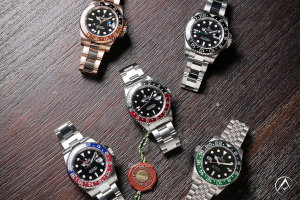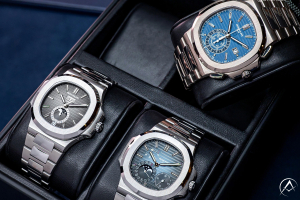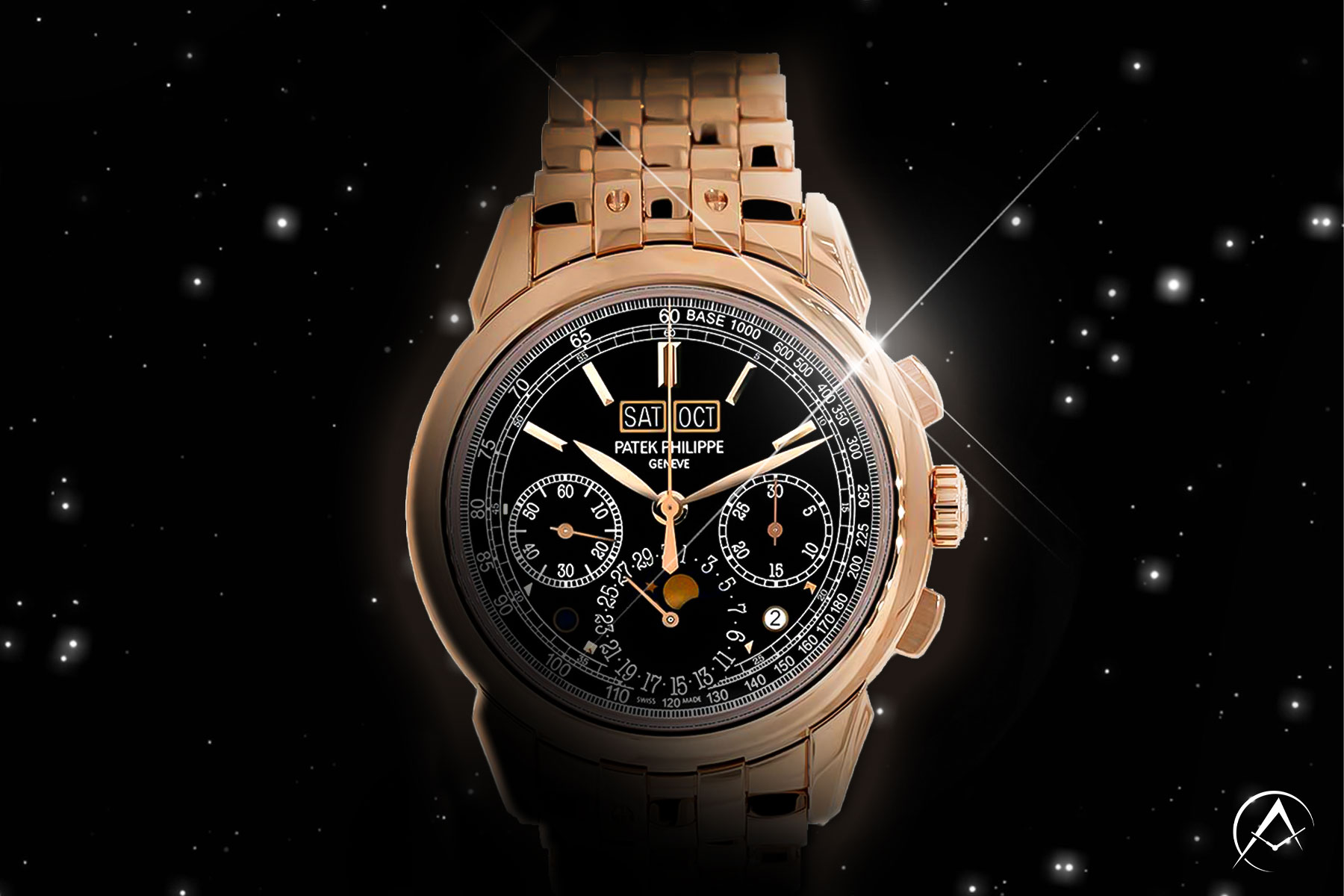
The moon is such a fantastical object: a big smile that pokes its head out during the night sky like a game of hide and seek. There have been songs written about it, stories both fictional and theoretical, and still, there’s so much to learn. The moonphase complication was one of the first types of watches that caught my eye because of its beauty, intelligence, and overall craftsmanship that glistens off the watch’s face just as the actual moon does.
A moon phase timepiece displays the sunlit portion of the moon as observed from Earth during each 29.5 day lunar month. That is how long a cycle takes to get from a hidden moon to a full moon. You can see the moon's current phase without going outside at night by looking through a small opening on the complication. Rolex introduced the complication in 1949, Audemars Piguet introduced it in 1985, and Patek Philippe introduced it in 2001.
The Development of the Moonphase Complication
People measured time by the rising and setting of the sun before clocks. The changing of the seasons and the phases of the moon could also measure it. Determining the phase of the moon helped sailors navigate the sea by determining the tides.
The Antikythera, an Ancient Greek mechanism from 150 BC, contains one of the oldest watch complications. They created it to show the annual pilgrimage of the sun and moon. The device also predicted the eclipse by mimicking the irregular movement of the moon around the Earth. No one was able to match the complication for nearly 2000 years.

The largest Antikythera Mechanism, which holds the main drive wheel.
During the Renaissance, people built astronomical clocks into churches and cathedrals to communicate the timing of public events. Built to impress as much as indicate moon phases, these complications showcased a clockmaker’s technical skills. Clocks were used to show that the sun, moon, and planets moved around the Earth. However, scientists discovered that the Earth is not the center of the universe.
Grandfather clocks built in Germany and England in the 16th century featured the moonphase complication. The moon function didn’t appear on a wristwatch until the 20th century. Although, by then, it was no longer a necessity for keeping time.
Types of Moonphase Complications and How They Work
Elegant and artistic, a lot of calculations go into creating the popular complication. LIV watches explain that a gear accomplishes the progression of the moon in a mechanical watch. The gear contains a specific number of teeth, 59 to be exact.
"The reason for this practice is to have two full moons, 180 degrees apart. This covers two complete moon cycles. Every 24 hours, the gear advances one tooth, moving the display forward.”
There are four primary lunar cycles: the new moon, the first quarter, the full moon, and the final quarter. In addition, there are four lunar phases: waxing crescent, waxing gibbous, waning gibbous, and waning crescent. (You can observe all of these on the moon phases chart below.) The watch world focuses on the synodic period. This is the time it takes for the moon to go through all eight phases before realigning with the sun.
There are two types of moonphase complications: radial moonphase and bosom moonphase. The radial complication uses an indicator hand to track the moonphase on a dial. The more eye-catching bosom complication physically shows the moon moving through its various phases using a crescent-shaped aperture.

Moon Phases Chart
The Moonphase Complication’s Accuracy and Design
Many timepieces have a moon phase display that requires resetting after about three years to maintain accuracy. However, brands like A. Lange & Sohne and Patek Philippe developed ones that boast over 1,000 years of accuracy.
Andreas Strehler, a Swiss watchmaker, received a Guinness World Record in 2014 for developing the 'Sauterelle à lune perpétuélle'. Its moon phase complication will remain accurate for an astonishing two million years. (A great investment if you’re hoping to pass down thousands of generations, I suppose!)
While some brands strive to make the elegant complication more accurate, others thrive to enhance their design. Designs of watches change over time to keep up with trends. The same could be said about the representation of the moon.
In the 16th and 17th centuries, the moon was cherub-like. This image didn’t evolve into a man on the moon until the 18th and 19th centuries. The early 20th century saw the moon with an art deco spin, and the later 20th century designed something more minimalistic.
The moon is much more realistic today. These designs are more often found on high-end timepieces because of the craftsmanship required to construct this movement.
Shop Avi & Co.’s Watches from Another Galaxy
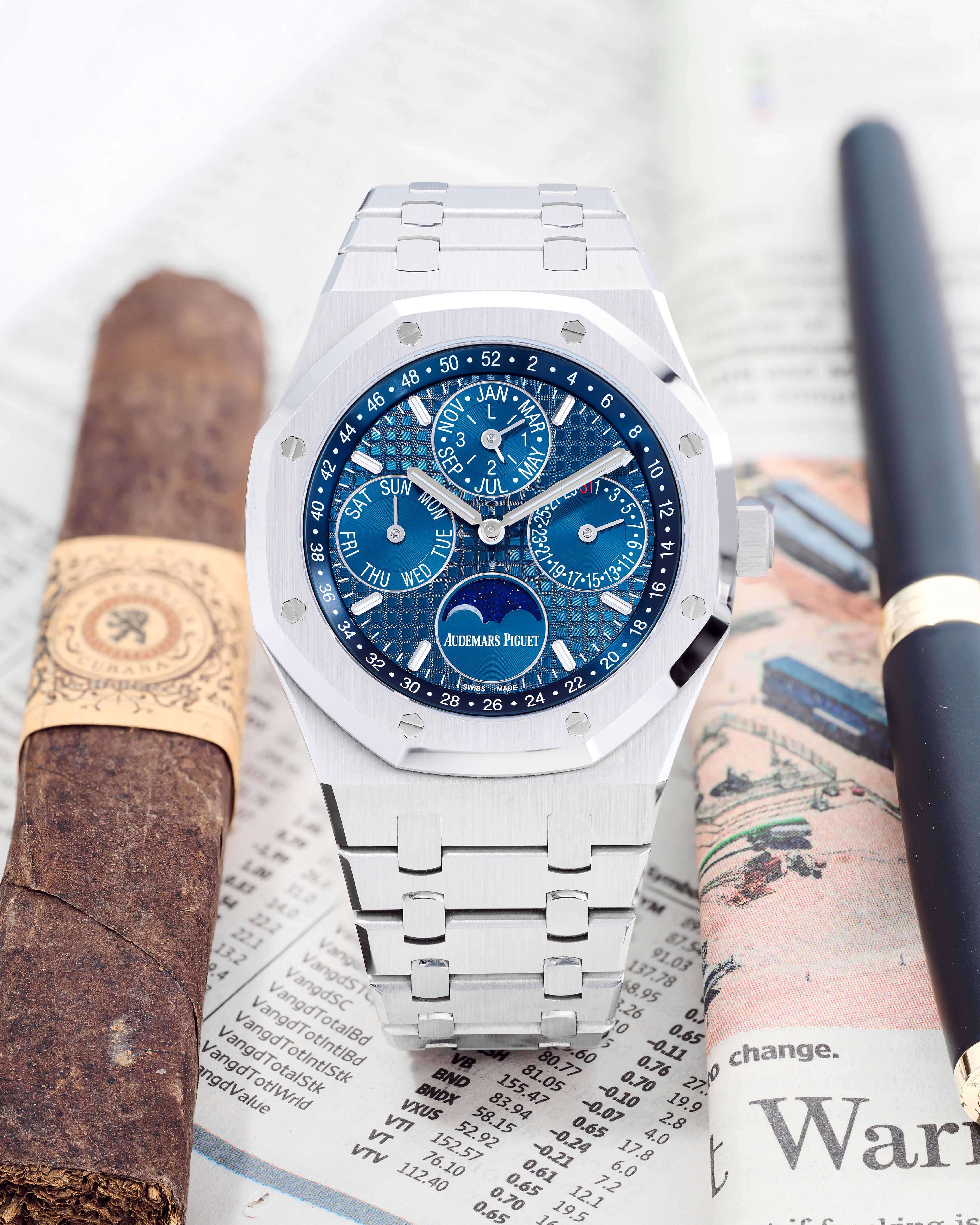
Audemars Piguet Royal Oak
In 2015, Audemars Piguet created the Perpetual Calendar Royal Oak. It had a modern design and used the iconic 'Night Blue, Cloud 50' color of the original Royal Oak. The stainless steel case is assembled with a fixed, matching bezel and water resistance of 66 feet. The self-winding 5134 calibre powers this timepiece, providing a 40-hour power reserve.
- Price: $132,599
- Original Factory Box and Papers Included
- Reference #26574ST

Omega Speedmaster
The wonders of space inspired the introduction of the Omega Moonphase Speedmaster in 2016. Incredibly detailed, a reproduction of Buzz Aldrin’s footprint appears on the lunar surface. The stainless steel 44 mm case is assembled with a tachymeter, ceramic bezel, and a screw-in crown. The self-winding 9904 calibre powers this timepiece, providing a 60-hour power reserve.
- Price: $10,699
- Original Factory Box and Papers Included
- Reference #304.30.44
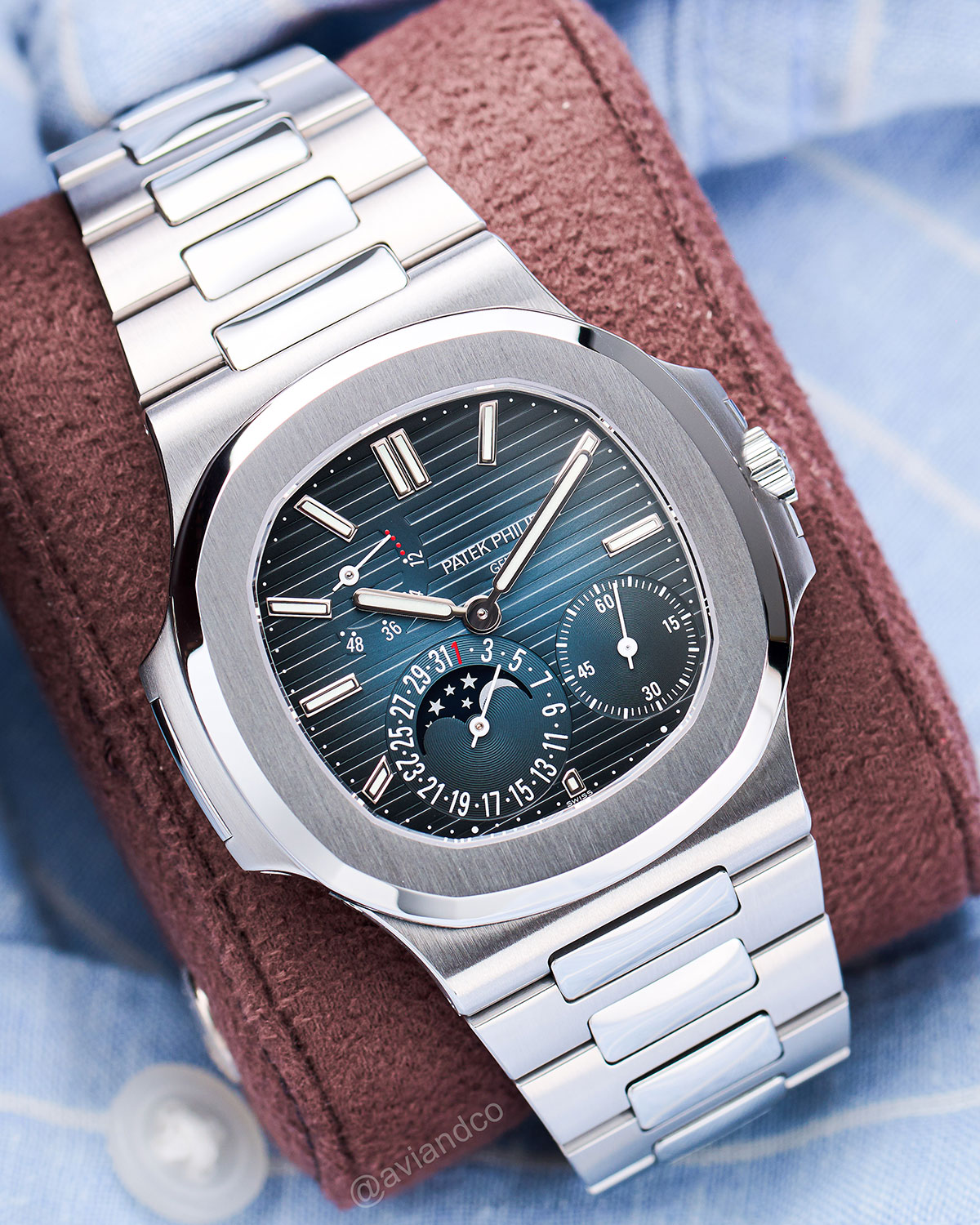
Patek Philippe Nautilus
Be sure to shop our additional Grand Complications with Moonphases.
You can keep track of all facets of time when you add a Nautilus Moonphase watch to your collection. The stainless steel 40 mm case is assembled with a fixed, stainless steel bezel, and a screw-down crown. The self-winding 240 PS IRM C LU calibre powers this timepiece, providing a 48-hour power reserve.
- Price: $148,499
- Original Factory Box and Papers Included
- Reference #5712/1A-001
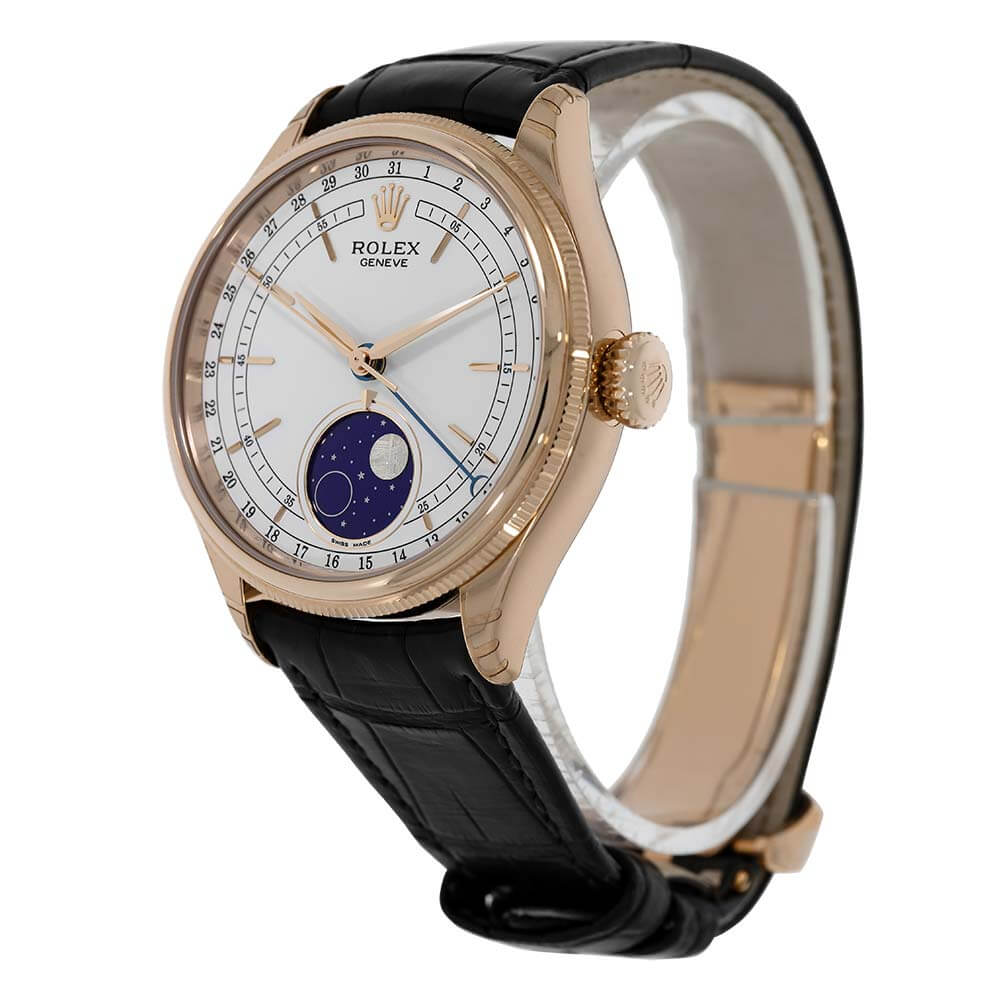
Rolex Cellini
In 2017, Rolex added a feature to their Cellini collection that shows the night sky in a beautiful rich blue dial. Its moonphase complication boasts accuracy for 122 years. The everose gold 39 mm case is assembled with a fluted, matching bezel and a screw-down crown. The self-winding 3195 calibre powers this timepiece, providing a 48-hour power reserve.
- Price: $32,499
- Original Factory Box and Papers Included
- Reference #50535
Celebrities who Love the Moonphase Complication
- Guitarist Eric Clapton owned the Patek Philippe (reference 2499/100) which sold at auction for $3,635,808.
- Beatles legend John Lennon received a Patek Philippe (reference 299) for his 40th birthday. It is thought to currently reside with Lennon’s family.
- In 1945, President Truman wore a Universal Geneve Tri-Compax, which featured a moonphase with a calendar display.
- Actor Mark Wahlberg has a large collection of Patek Philippe timepieces, including the Sky-Moon Tourbillon in rose gold. It features an impressive 12 complications.
- Nick Jonas wore a white gold Omega Speedmaster Moonwatch for his music video Spaceman.
- Robert Downey Jr. has an extensive collection of timepieces. He enjoys wearing his stainless steel Patek Philippe Nautilus Moonphase, a gift from his wife Susan Downey.
Robert Downey Jr. wearing Patek Philippe Nautilus Moonphase
Why is the moonphase complication still popular today?
It has become less common to use the moon as a clock. Despite this, its movement continues to fascinate people. In 2015, a Patek Philippe Moonphase watch (reference #1518) made $11 million at auction. At the time, this was the most expensive watch ever sold.
People appreciate tracking the moon’s movements and enjoy the aesthetic it has on a timepiece. The moon is a romantic and fascinating motif. Even with the knowledge we have, a lot of its secrets remain hidden. The secrets are only visible through reflecting on it through literature, music, and art.
We hope to continue your journey with an elegant complication that is perfect to wear as a dress watch. Contact our representatives today for a private viewing or virtual online meeting.
*Please Note: Prices seen in this article are subject to change based on the market.

 By
By 


